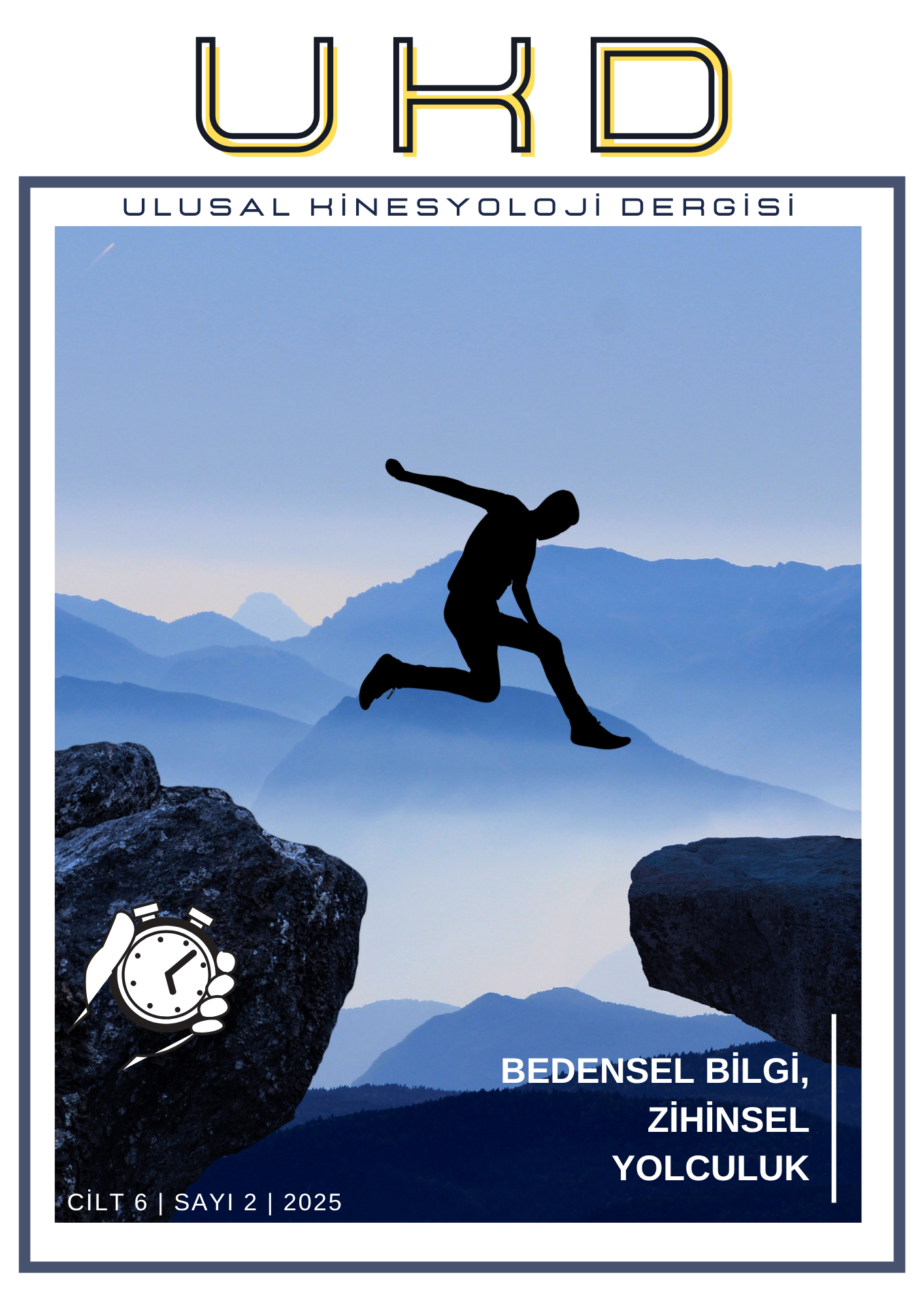Erkek hentbolcularda antropometrik ve motorik özelliklerin sıçrayarak atış hızı üzerindeki yordayıcı rolü
Abstract
The aim of this study is to investigate the relationships between jump ball speed and various anthropometric and motoric characteristics in young male handball players. The study group consists of 14 elite level male handball players with a mean age of 18.85±0.36 years. Within the scope of anthropometric characteristics of the participants, height, body weight, body mass index (BMI), stroke length, bust length, hand length and hand width were measured. Motoric capacities were evaluated with variables such as leg strength, agility, reaction time, flexibility, grip strength and speed. Jump ball speed used as a performance indicator was determined accurately and reliably by radar speed measuring device. Pearson correlation and multiple linear regression analyses were used in the analysis of the data. As a result of correlation analyses, significant relationships were found between jump ball speed and stroke length (r = 0.674; p = 0.008), agility (r = 0.604; p = 0.022), reaction time (r = –0.672; p = 0.008), flexibility (r = 0.567; p = 0.034) and grip strength (r = 0.568; p = 0.034). According to the regression analysis results, significant predictors of jump ball speed were determined as stroke length (β = 0.492; p = 0.050), agility (β = –0.568; p = 0.021), reaction time (β = –0.438; p = 0.039) and flexibility (β = 0.567; p = 0.027). The regression model established explains 64.2% of the variance (R² = 0.642; F(4,9) = 8.982; p = 0.001). The findings reveal that not only technical skills but also anthropometric and motoric characteristics that form the basis of these skills are decisive in increasing the speed of the jump shot ball. Therefore, it is recommended that training programs be structured to develop motoric characteristics such as quickness, flexibility and reaction time.
Downloads
References
Baechle, T. R., & Earle, R. W. (2008). Essentials of strength training and conditioning. 3rd ed.. Human Kinetics, pp. 100–130.
Büyüköztürk, Ş., Kılıç Çakmak, E., Akgün, Ö. E., Karadeniz, Ş., & Demirel, F. (2022). Bilimsel araştırma yöntemleri. 29. baskı. Pegem Akademi, s. 26.
Chelly, M. S., Hermassi, S., & Shephard, R. J. (2011). Relationships between power and strength of the upper and lower limb muscles and throwing velocity in male handball players. Journal of Strength and Conditioning Research, 25(3), 716–722. https://doi.org/10.1519/JSC.0b013e3181c64e77
Gorostiaga, E. M., Granados, C., Ibáñez, J., & Izquierdo, M. (2005). Differences in physical fitness and throwing velocity among elite and amateur male handball players. International Journal of Sports Medicine, 26(3), 225–232. https://doi.org/10.1055/s-2004-820933
Granados, C., Izquierdo, M., Ibáñez, J., Ruesta, M., & Gorostiaga, E. M. (2007). Differences in physical fitness and throwing velocity among elite and amateur male handball players. International Journal of Sports Medicine, 28(10), 860–867. https://doi.org/10.1055/s-2007-965156
Hermassi, S., Chelly, M. S., Tabka, Z., Gmada, N., & Shephard, R. J. (2011). Effects of a short-term in-season plyometric training program on repeated sprint and throwing performance in elite handball players. Journal of Strength and Conditioning Research, 25(9), 2424–2433. https://doi.org/10.1519/JSC.0b013e3181fb4a46
Hermassi, S., Chelly, M. S., Tabka, Z., Gmada, N., & Shephard, R. J. (2011). Effects of strength training on throwing velocity and muscle strength in handball players. Journal of Sports Science and Medicine, 10(2), 284–291.
Innes, E. (1999). Handgrip strength testing: A review of the literature. Australian Occupational Therapy Journal, 46(3), 120–140. https://doi.org/10.1046/j.1440-1630.1999.00182.x
Karasar, N. (2022). Bilimsel araştırma yöntemi. 35. baskı. Nobel Yayıncılık, s. 113.
Markovic, G., Dizdar, D., Jukic, I., & Cardinale, M. (2004). Reliability and factorial validity of squat and countermovement jump tests. Journal of Strength and Conditioning Research, 18(3), 551–555. https://doi.org/10.1519/00124278-200408000-00028
Massuca, L., Fragoso, I., & Jesus, F. (2015). Role of physical fitness and anthropometric characteristics on playing performance in elite team-handball players. Journal of Sports Medicine and Physical Fitness, 55(5), 414–422.
Massuca, L., Fragoso, I., & Teles, J. (2015). Relationship between anthropometric factors and throwing velocity in elite male handball players. Journal of Human Kinetics, 45(1), 73–83. https://doi.org/10.1515/hukin-2015-0018
Mohamed, H., Vaeyens, R., Matthys, S., Multael, M., Lefevre, J., Lenoir, M., & Philippaerts, R. M. (2009). Anthropometric and performance measures for the development of a talent detection and identification model in youth handball. Journal of Sports Sciences, 27(3), 257–266. https://doi.org/10.1080/02640410802482417
Mohamed, H., Vaeyens, R., Matthys, S., Multael, M., Lefevre, J., Lenoir, M., & Wisloff, U. (2009). Anthropometric and performance measures for the development of a talent detection and identification model in youth handball. Journal of Sports Sciences, 27(4), 395–403. https://doi.org/10.1080/02640410802632157
Póvoas, S. C. A., Seabra, A. F. T., Ascensão, A. A. M. R., Magalhães, J. J., & Soares, J. M. C. (2014). Physical and physiological demands of elite team handball. Journal of Strength and Conditioning Research, 28(4), 1212–1220. https://doi.org/10.1519/JSC.0000000000000275
Tamer, K. (2000). Sporda fiziksel–fizyolojik performansın ölçülmesi ve değerlendirilmesi. Bağırgan Yayınevi, s. 77.
Wagner, H., Finkenzeller, T., Würth, S., & von Duvillard, S. P. (2010). Individual and team performance in team-handball: A review. Journal of Sports Science and Medicine, 9(3), 323–333.
Wagner, H., Pfusterschmied, J., Buchecker, M., Müller, E., & Müller, W. (2010). Skill- and motion-dependent biomechanical loading of the shoulder in team-handball players during a penalty throw. Journal of Sports Sciences, 28(5), 491–499. https://doi.org/10.1080/02640410903508884
World Health Organization. (2020). Body mass index – BMI., s. 5. https://www.who.int/news-room/fact-sheets/detail/obesity-and-overweight
World Medical Association. (2013). World Medical Association Declaration of Helsinki: Ethical principles for medical research involving human subjects. JAMA, 310(20), 2191–2194. https://doi.org/10.1001/jama.2013.281053
Downloads
Published
How to Cite
Issue
Section
License
Copyright (c) 2025 Ahmet Nusret Bulgurcuoğlu- Ramazan Sanlav

This work is licensed under a Creative Commons Attribution-NonCommercial 4.0 International License.





